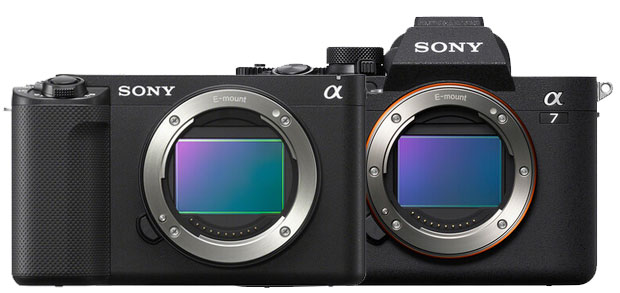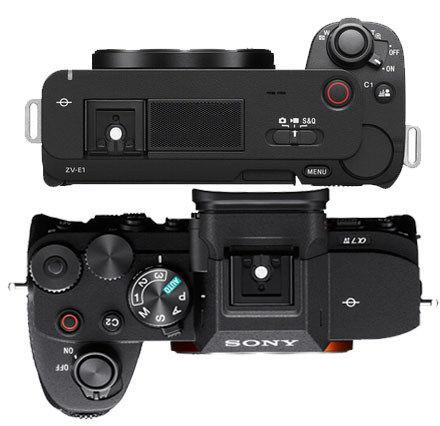
Sony ZV-E1 vs Sony A74 – let’s have a deeper drive and find out which camera is best for you. The biggest advantage associated with the Sony 74 camera is its body design.
Also, see – Sony ZV-E1 vs Sony FX30
BODY DESIGN
If you are a photographer and doing a long photography assignment that will take approx 3 to 4 hours or maybe you are a kind of wedding photographer or event shooter in those specific scenarios you need to have a camera that perfectly fits in your hand and you feel very comfortable to hold. In those specific situations when you have to work for a very long period Sony A74 camera body design is super perfect without a single doubt. When u have an extra slim camera in ur hand u have to balance it always feels like ur losing the grip. So, for photographers, it’s very important to select a camera with the perfect body design.
Buy Sony ZV-E1 – B&H Store | Amazon.com
- Sony ZV-E1 Best Lenses for Content Creators – B&H Store | Amazon.com
- Sony ZV-E1 Best Lenses for Cinematographers – B&H Store | Amazon.com
Sony ZV-E1 camera is more compact, has a sleek body without any electronic viewfinder, and also the grip is very similar to the entry-level APS-C bodies. So, it is made like to be placed in a gimbal or a selfie stick to record the videos perfectly. The Intention of the design is not favorable for photographers, there yes you can click some occasional pics but it is not made for that.

MORE RESOLUTION = MORE DETAILS
Another Major advantage associated with the Sony A74 camera is the higher resolution 33-megapixel full-frame CMOS sensor. If you are a photographer you feel very limited while using a 12-megapixel full-frame sensor and snapping pics. if you have to do a digital crop the 12-megapixel image will not allow you to do that.
The Biggest advantage that I feel in using a higher resolution camera is that you get more and more details while zooming ( @100 % scale) if you are a pixel-peeper. if you like to see more details in a given frame of a scene, it’s highly recommended that photographers use your higher resolution sensor instead of having a lower resolution as we have in the Sony ZE-V1 camera
BEST CAMERA FOR PHOTOGRAPHERS
Design-wise and based on the type of sensor being used inside both the camera it’s highly recommended that if you are a photographer you should go with a Sony A74 camera at the same time if you are more into videography if you are more into content creation and you shoot occasionally few pics you can use the Sony ZV-E1 camera. Yes, you can use your A74 camera as a backup camera for shooting your pics. but it cannot be used as a primary photographic tool if you are into professional work out there.

BEST CAMERA FOR RECORDING VIDEO
In the video part without having a single doubt in your head you should pick Sony’s latest ZV-E1 camera.
The reason behind that the camera can shoot for case 60 frames per second without any crop whereas we all know with the Sony is A74 camera, we have to face APS-C crop, or if you say with some butter that we are shooting in a super 35 mm format while using A74 in 4k 60p mode,
With Sony ZV- E1 camera we do not have any of such used even the camera allows you to suit 4K 120 FPS maybe the firmware update which is about to arrive in June 2023 the cost you a bit that’s another matter but you can suit 4K 120 happiest with only 10% crop which is not similar to the A7 4K 60p super 35 mm all that crop.
now the other biggest advantage that you will enjoy in Sony’s latest ZV-E1 camera is the introduction of a dedicated artificial intelligence chip that was the first scene in Sony’s A7 are 5 camera announcement now the chip has been improved to perform better functionality at the same time new features also being introduced inside this camera.
Overall if you are into content creation videography cinematography in any way you are associated with a video you must buy the latest Sony Z1 camera instead of the Sony is 74
Sony ZV-E1 vs. Sony A7 IV – Best Vlogging Camera for 2023
| Lens Mount | Sony ZV-E1 | Sony A74 |
| Sensor Resolution | Effective: 12.9 Megapixel (4240 x 2832) | Actual: 34.1 Megapixel Effective: 33 Megapixel |
| Sensor Type | 35.6 x 23.8 mm (Full-Frame) CMOS | 35.9 x 23.9 mm (Full-Frame) CMOS |
| Image Stabilization | Sensor shift, 5-Axis | Sensor-Shift, 5-Axis |
| Built-In ND Filter | None | None |
| Capture Type | Stills & Video | Stills & Video |
Exposure Control
| Shutter Type | Electronic Shutter | Electronic Shutter, Mechanical Focal Plane Shutter |
| Shutter Speed | 1/8000 to 30 Second 1/8000 to 1 Second in Movie Mode |
1/8000 to 30 Seconds |
| ISO Sensitivity | Photo 80 to 102,400 (Extended: 80 to 409,600) |
Photo 100 to 51,200 (Extended: 50 to 204,800) Video 100 to 51,200 (Extended: 100 to 102,400) |
| Metering Method | Center-Weighted Average, Highlight Weighted, Multiple, Spot | Aperture Priority, Manual, Program, Shutter Priority |
| Metering Range | 3 to 20 EV | -3 to 20 EV |
Video Details – Comparison of Resolution and frame rates
| Internal Recording Modes | RawXAVC HS 4:2:0 10-Bit UHD 4K (3840 x 2160) at 50/59.94 fps [45 to 150 Mb/s] UHD 4K (3840 x 2160) at 23.98 fps [30 to 100 Mb/s] RawXAVC HS 4:2:2 10-Bit 3840 x 2160 at 50/59.94 fps [100 to 200 Mb/s] 3840 x 2160 at 23.98 fps [50 to 100 Mb/s] RawXAVC S 4:2:2 8-Bit UHD 4K (3840 x 2160) at 50/59.94 fps [100 to 200 Mb/s] UHD 4K (3840 x 2160) at 25/29.97 fps [140 Mb/s] RawXAVC S 8-Bit 1920 x 1080p at 100/120 fps [60 to 100 Mb/s] 1920 x 1080p at 50/59.94 fps [25 to 50 Mb/s] RawXAVC S 10-Bit 1920 x 1080p at 23.98/25/29.97/50/59.94 fps [50 Mb/s] RawXAVC S-I 10-Bit 3840 x 2160 at 59.94 fps [600 Mb/s] 3840 x 2160 at 50 fps [500 Mb/s] 3840 x 2160 at 29.97 fps [300 Mb/s] 3840 x 2160 at 25 fps [250 Mb/s] 3840 x 2160 at 23.98 fps [50 Mb/s] 1920 x 1080p at 59.94 fps [222 Mb/s] 1920 x 1080p at 50 fps [185 Mb/s] 1920 x 1080p at 29.97 fps [111 Mb/s] 1920 x 1080p at 25 fps [93 Mb/s] 1920 x 1080p at 23.98 fps [89 Mb/s] |
H.265/XAVC HS 4:2:2 10-Bit UHD 4K (3840 x 2160) at 23.98/50/59.94 fps [50 to 200 Mb/s] H.265/XAVC HS 4:2:0 10-Bit UHD 4K (3840 x 2160) at 23.98/50/59.94 fps [30 to 150 Mb/s] H.264/XAVC S-I 4:2:2 10-Bit UHD 4K (3840 x 2160) at 23.98/25/29.97/50/59.94 fps [240 to 600 Mb/s] 1920 x 1080p at 23.98/25/29.97/50/59.94 fps [89 to 222 Mb/s] XAVC S 4:2:2 10-Bit UHD 4K (3840 x 2160) at 23.98/25/29.97/50/59.94 fps [100 to 200 Mb/s] 1920 x 1080p at 23.98/25/29.97/50/59.94 fps [50 Mb/s] XAVC S 4:2:0 8-Bit UHD 4K (3840 x 2160) at 23.98/25/29.97/50/59.94 fps [60 to 150 Mb/s] 1920 x 1080p at 23.98/25/29.97/50/59.94/100 fps [16 to 100 Mb/s] |
Interface
| Media/Memory Card Slot | Slot 1: CFexpress Type A / SD (UHS-II) Slot 2: SD/SDHC/SDXC (UHS-II) |
Single Slot: SD/SDHC/SDXC (UHS-II) |
| Video I/O | 1 x HDMI Output | 1X HDMI |
| Audio I/O | 1 x 1/8″ / 3.5 mm TRS Stereo Headphone Output 1 x 1/8″ / 3.5 mm TRS Stereo Microphone Input |
1 x 1/8″ / 3.5 mm TRS Stereo Microphone Input 1 x 1/8″ / 3.5 mm TRS Stereo Headphone Output |
| Power I/O | 1 x USB-C Input/Output | 1 x USB-C Input |
| Other I/O | 1 x Sony Multi/Micro-USB Input/Output (Shared with Remote Input) 1 x USB-C (USB 3.2 / 3.1 Gen 2) Input/Output (Shared with Power Input) |
1 x USB-C (USB 3.2 / 3.1 Gen 1) Data Input/Output (Shared with Power Input) 1 x Sony Multi/Micro-USB Control |
| Wireless | Wi-Fi, Bluetooth | Wi-Fi, Bluetooth |
| Mobile App Compatible | No *As of October, 2021: Check with manufacturer for the most up-to-date compatibility |
Yes *As of March, 2023: Check with manufacturer for the most up-to-date compatibility |
| Global Positioning (GPS, GLONASS, etc.) | None | None |
Monitor
| Size | 3.0″ | 3.0″ |
| Resolution | 1,036,800 Dot | 1,036,800 Dot |
| Display Type | Articulating Touchscreen LCD | Free-Angle Tilting Touchscreen LCD |
| EVF | NO | YES |
Also, see – Sony ZV-E1 vs Sony FX30
Buy Sony ZV-E1 – B&H Store | Amazon.com
- Sony ZV-E1 Best Lenses for Content Creators – B&H Store | Amazon.com
- Sony ZV-E1 Best Lenses for Cinematographers – B&H Store | Amazon.com






